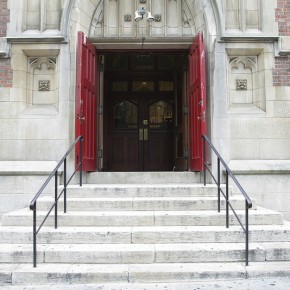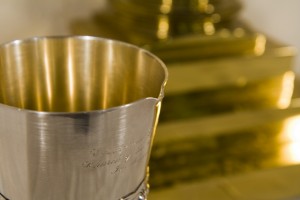I’ll admit that I’m not the most biblically literate person out there. Sure, I’ve read the entire bible serveral times and I’ve picked apart several books, but when it comes to the memorization of storylines and plot points, the devil is in the details. My lack of being able to memorize details is legendary. My wife is a wonderful singer and can pick up a tune easily and quickly. I’m the complete opposite. There are songs that are in my all-time top ten, songs that I have listened to a thousand times, that I could not sing right now if someone asked me to. It’s pitiful really. Route memorization sometimes works for me but when it comes to learning-through-exposure, I’m a failure. If I want to learn something, I need to study it or experience it in multiple forms of media. And that’s probably why I never can remember correctly how David, in 1 Samuel, kills Goliath. I always forget how he dies.
My internship church has spent the summer preaching through the semi-continous lectionary series. This season, the focus is on David, with a little Saul and Solomon thrown in for good measure. I’ll be preaching during the next two Sundays, covering Solomon’s dedication at the temple and a bit from Song of Songs. Besides preaching, I’ll also be leading a bible study on the specific passage that we are covering. Not wanting to be ill-prepared, I decided to review the entire David-Solomon story line which is why I found myself re-reading David’s fight with Goliath. It was our lectionary reading for June 24.
1 Samuel 17:[1a, 4-11, 19-23] 32-49; NRSV
(1) Now the Philistines gathered their armies for battle; they were gathered at Socoh, which belongs to Judah, and encamped between Socoh and Azekah, in Ephes-dammim. (4) And there came out from the camp of the Philistines a champion named Goliath, of Gath, whose height was six cubits and a span. (5) He had a helmet of bronze on his head, and he was armed with a coat of mail; the weight of the coat was five thousand shekels of bronze. (6) He had greaves of bronze on his legs and a javelin of bronze slung between his shoulders. (7) The shaft of his spear was like a weaver’s beam, and his spear’s head weighed six hundred shekels of iron; and his shield-bearer went before him.
(8) He stood and shouted to the ranks of Israel, “Why have you come out to draw up for battle? Am I not a Philistine, and are you not servants of Saul? Choose a man for yourselves, and let him come down to me. (9) If he is able to fight with me and kill me, then we will be your servants; but if I prevail against him and kill him, then you shall be our servants and serve us.” (10) And the Philistine said, “Today I defy the ranks of Israel! Give me a man, that we may fight together.” (11) When Saul and all Israel heard these words of the Philistine, they were dismayed and greatly afraid.
(19) Now Saul, and they, and all the men of Israel, were in the valley of Elah, fighting with the Philistines. (20) David rose early in the morning, left the sheep with a keeper, took the provisions, and went as Jesse had commanded him. He came to the encampment as the army was going forth to the battle line, shouting the war cry. (21) Israel and the Philistines drew up for battle, army against army. (22) David left the things in charge of the keeper of the baggage, ran to the ranks, and went and greeted his brothers. (23) As he talked with them, the champion, the Philistine of Gath, Goliath by name, came up out of the ranks of the Philistines, and spoke the same words as before. And David heard him.
(32) David said to Saul, “Let no one’s heart fail because of him; your servant will go and fight with this Philistine.”
(33) Saul said to David, “You are not able to go against this Philistine to fight with him; for you are just a boy, and he has been a warrior from his youth.”
(34) But David said to Saul, “Your servant used to keep sheep for his father; and whenever a lion or a bear came, and took a lamb from the flock, (35) I went after it and struck it down, rescuing the lamb from its mouth; and if it turned against me, I would catch it by the jaw, strike it down, and kill it. (36) Your servant has killed both lions and bears; and this uncircumcised Philistine shall be like one of them, since he has defied the armies of the living God.”
(37) David said, “The LORD, who saved me from the paw of the lion and from the paw of the bear, will save me from the hand of this Philistine.” So Saul said to David, “Go, and may the LORD be with you!”
(38) Saul clothed David with his armor; he put a bronze helmet on his head and clothed him with a coat of mail. (39) David strapped Saul’s sword over the armor, and he tried in vain to walk, for he was not used to them. Then David said to Saul, “I cannot walk with these; for I am not used to them.” So David removed them. (40) Then he took his staff in his hand, and chose five smooth stones from the wadi, and put them in his shepherd’s bag, in the pouch; his sling was in his hand, and he drew near to the Philistine.
(41) The Philistine came on and drew near to David, with his shield-bearer in front of him. (42) When the Philistine looked and saw David, he disdained him, for he was only a youth, ruddy and handsome in appearance. (43) The Philistine said to David, “Am I a dog, that you come to me with sticks?” And the Philistine cursed David by his gods. (44) The Philistine said to David, “Come to me, and I will give your flesh to the birds of the air and to the wild animals of the field.”
(45) But David said to the Philistine, “You come to me with sword and spear and javelin; but I come to you in the name of the LORD of hosts, the God of the armies of Israel, whom you have defied. (46) This very day the LORD will deliver you into my hand, and I will strike you down and cut off your head; and I will give the dead bodies of the Philistine army this very day to the birds of the air and to the wild animals of the earth, so that all the earth may know that there is a God in Israel, (47) and that all this assembly may know that the LORD does not save by sword and spear; for the battle is the LORD’S and he will give you into our hand.”
(48) When the Philistine drew nearer to meet David, David ran quickly toward the battle line to meet the Philistine. (49) David put his hand in his bag, took out a stone, slung it, and struck the Philistine on his forehead; the stone sank into his forehead, and he fell face down on the ground.
It is a lovely reading, isn’t it? As I glance over it, I see a Goliath, huge and warlike, and a king and army that are afraid to face this super weapon. Every day, they do. They form up in defiance of the enemy but they never engage. It is a cold war of intimidation. A young boy/man arrives to visit his brothers. He sees this super weapon and decides, for love of his people and his God, to engage it. He is confident that he can win. When King Saul tries to dress him in armor, the young man removes it. He cannot fight in what he is not use to. He instead dresses in the armor that he has always worn – the armor of a faithful shepherd. This young man walks into the fight, smack talks his enemy, and wins. He slings a stone into the forehead of this super weapon. The simple stone, in a simple sling, fells the armor behemoth. The enemy collapses, his face hitting the ground. He is presumed dead. It is a great story and it is an incomplete story.
To complete the story, one needs to read the parts that are missing. What we discover is that the political innocence and selflessness of David is tempered by the reality that he is a young man full of political ambition. After David first hears Goliath speak, he also hears the rumor that has spread throughout the ranks of the army: “The Israelites said, ‘Have you seen this man who has come up? Surely he has come up to defy Israel. The king will greatly enrich the man who kills him, and will give him his daughter and make his family free in Israel.'” (1 Samuel 17:25). The anointed the future king of Israel (see 1 Samuel 16) spends several verses trying to confirm this rumor. He wants the reward – and the promises that such a reward would bring to his family and himself. He is not merely a young man, innocent, and bravely defending his people and his God. He is a young man with political ambition, hopes, thoughts, and the utmost confidence in his own ability to be joined into Saul’s household. If the plot points are in the right order, it might be that David, after being the lyre player in Saul’s household for a bit, decides that there is glory there that he wants a part of. Whatever the truth, the reality is that we see a young man who is not selfless in how I would define it. Rather, we see a politically ambitious young man seeing an avenue for advancement. David, foreshadowing his later career, jumps at the chance, confident that he will succeed where others dare not to trend.
Besides David’s political ambition, this lectionary reading hides how Goliath dies. In 1 Samuel 17:51, the reader is told: “then David ran and stood over the Philistine; he grasped his sword, drew it out of its sheath, and killed him; then he cut off his head with it.” David prevailed in combat and, like all players of Mortal Kombat will recognize, David decided to “FINISH HIM.” David removes Goliath’s head from his shoulders. Is the lack of this detail in the lectionary reading important? I think so. For modern readers in the United States, I wonder if our experience with war being a long-range affair – guns, missiles, ICBMs – and all these battles occurring in distant lands – we identify with the sling more than the sword. But the sling serves as a weapon of distance – a weapon that leaves its heaver (in the modern eye) untarnished by blood and gore. It is a “clean” weapon. It is unlike the sword. It does not seem personal. And, above all, it keeps David’s hands clean, sanitized, and pure.
I forgot that David personally kills Goliath with a sword because I usually envision the battle with Goliath like this:

It is the story told in clip art, church newsletters, Sunday schools, and confirmation classes. I rarely see the battle like this:

So why is that? Why is David sanitized, not only in our lectionary reading, but also in our churches? Is this a bleed through problem – where our own vision of Jesus, as one of the house of David, ends up forcing us to see David through more culturally pure eyes? Does Jesus, the one with no sin, end up cleaning David – even if we read David and Bathsheba during worship? Is our obsession with purity and hygiene influencing our lectionary and reading of scripture? These are all questions that I think I have an answer to – there is a tendency to white wash religion. And I think that this is normal, natural, and an intrinsically human thing to do. Even for left-leaning theologians, scripture tends to be made gritty in a non-dirty way. If, for example, we claim that Christ has a radical sense of welcome to others, there is still a tendency, I think, to claim grittiness without actually getting dirty. I’m not sure how exactly to word that but I feel, as a church, we can sometimes claim to be incarnational but only to a degree. We allow Christ to be human but only so much. Christ is handled as a demi-god, but not like the demi-gods of Greece with human problems, emotions, desires and fears. He is instead a demi-GOD – a being where our vision of the purity of the Creator clears any blemishes from his being. We, in some ways, ignore the creedal claim that Jesus Christ was truly human. In the quest to define what it means to be truly human, we purify Christ and see to purify ourselves and others. And when we can’t, or when we forget that we live with biases that actually endorse and encourage purity divisions within communities, even those who are left-leaning end up sanitizing our own religious history. We reframe David to be innocent and pure through out culture’s eyes and we forget, like I always seem to, that there is blood on his hands. And for a church that eats body and drinks blood every Sunday, that just seems like a very weird thing to do.











